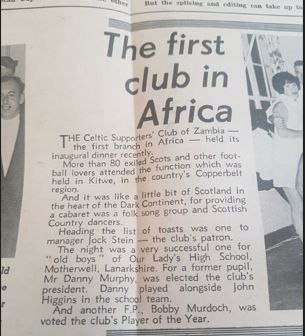| Misc |
Details
Ref: Black Players, Players of African descent, African-Americans, Afro-Caribbean descent, non-white
Note: This article below mostly concentrates on those of African descent who identify as Black African, a separate article will be written in time on those of for example Arabic descent, and later of other ethnic groups (e.g. East & South Asian, Latin American etc).
Summary
| “It’s not the creed nor his nationality that counts. It’s the man himself.” Willie Maley |
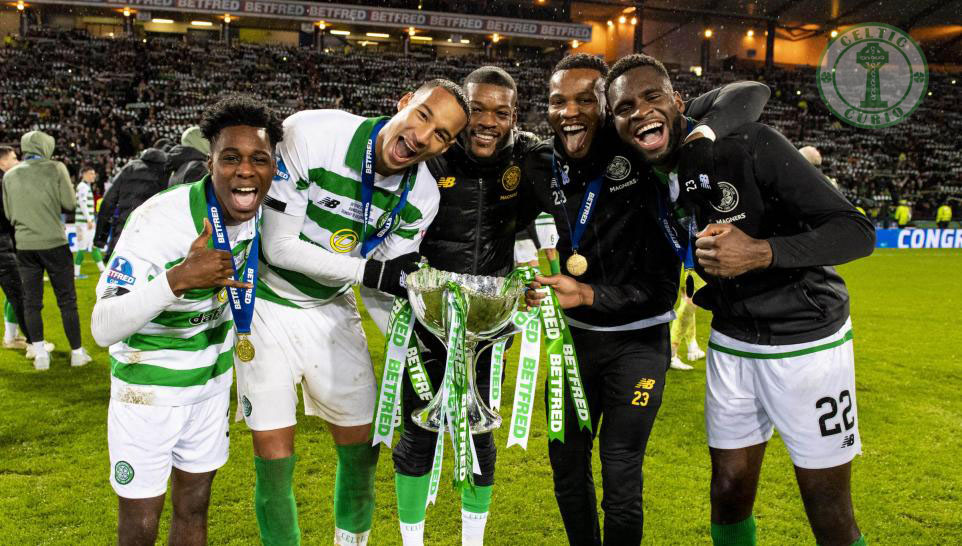 The above quote is one of the most repeated across all Celtic media. It underpins the ethos of the club but also emphasises important points, which, in reflection of the social history & background that Celtic has had to challenge in Scotland, is an important point.
The above quote is one of the most repeated across all Celtic media. It underpins the ethos of the club but also emphasises important points, which, in reflection of the social history & background that Celtic has had to challenge in Scotland, is an important point.
As the Irish-Catholic community has built and integrated in Scotland, there have been waves of other cultures that have grown in Scotland, such as the Asian communities (Pakistani & Indian in particular) and increasingly since the early 2000s the Eastern European & Black African communities.
In January 2018, Celtic defeated Hearts 3-1 in another match that pushed Celtic to the domestic treble. The three scorers were Edouard, Dembele and Ntcham. All three were of African descent (albeit now long based in Europe), and of differing religious beliefs, and no one batted an eyelid at Celtic. The three were highly regarded, and were key players in Celtic’s first team.
It clearly demonstrated the full integration and acceptance regardless of colour, race, religion etc, and that was a clear evolution of the game in Scotland.
One of the significant aspects of this moment was that of the demographic change in football that had been going on over recent generations in football, and Celtic were a proud part of this. Not by any means the first black footballers at Celtic, yet in its own way this match reinforced to all the ascent of the African footballers, who in the past were often patronised and/or derided in footballing circles.
In contrast to the early days of the club, times were very different and in general people weren’t as wholly socially aware of foreign cultures and people as now, which could lead to what is now seen as incredibly offensive behaviour when likely it was never the intention at the time. For example, at an Annual Festival of the United Celtic Break Clubs in 1896 one of the ‘Artists‘ advertised to provide entertainment (sic!) was a Mr J. A. Wilson who was to perform as an ‘Eccentric Negro Comedian and Dancer‘ (sic!). In the modern day, we can all only cringe and apologise when reading that back. Thankfully such acts are now in the dustbin of history.
The below is not an exhaustive list but is a snapshot timeline of the progress of non-white African descent players to have played at Celtic from the early days where it was possibly initially a novelty for some supporters on the terraces to then being an established & respected part of the whole squad.
Notable Points & Landmarks in Chronological Order
1) 1898: John Walker of Hearts
 In December 1898, Celtic played Hearts in the League and won 3-2. One of the Hearts players was the mixed-race John Walker who is likely the first non-white player to have ever played in a Celtic first team game (for or against Celtic).
In December 1898, Celtic played Hearts in the League and won 3-2. One of the Hearts players was the mixed-race John Walker who is likely the first non-white player to have ever played in a Celtic first team game (for or against Celtic).
He was born in Leith, and was of West Indian descent. He sadly died prematurely only two years after his appearance against Celtic from tuberculosis, he was only 22.
Note: It’s possible that (mixed race) Billy Clarke played v Celtic which could pre-date John Walker, but as of time of writing, there is no confirmed evidence/record as of yet found that he ever did. Billy Clarke had played in Scotland for Benburb, Crown Athletic, Third Lanark, Arthurlie & East Stirlingshire. He didn’t get to play for Third Lanark’s first team, and only signed for Arthurlie earliest in 1898 but didn’t play for Arthurlie v Celtic we believe from our checks to date (e.g. Jan 1898 Arthurlie 0-7 Celtic). It is not confirmed if he ever played for Benburb but from our records Celtic never played them in a major competition at least. If anything, then at most he may have possibly faced a Celtic side in a reserve team match.
2) 1899: ‘The Kaffirs’ tour of the UK from South Africa
The first football team consisting of all ‘non-white’ players to have played at Celtic Park were the touring South African team self-dubbed ‘The Kaffirs‘ who played a series of friendly matches across the UK. Mostly played as a friendly tour match as can be seen by some Celtic players playing in different positions to their norm.
3) 1951-52: Giles Heron
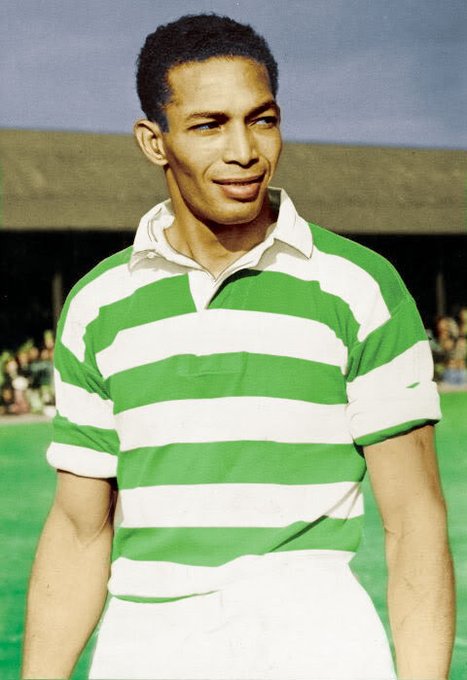 Despite the progress in the early days in football, there was actually little to no further progress for many years throughout football in the UK. It wasn’t until Giles Heron arrived at Celtic from the US & Caribbean that Celtic’s first team had a regular starting player of Black African descent.
Despite the progress in the early days in football, there was actually little to no further progress for many years throughout football in the UK. It wasn’t until Giles Heron arrived at Celtic from the US & Caribbean that Celtic’s first team had a regular starting player of Black African descent.
He may have only stayed at Celtic for a short time but his impact was great, and has been proudly recalled over successive generations by the Celtic support. His son was the legendary Gil Scott Heron who was to become seminal in the development of various genres of music of ‘black’ origin (including hip hop and rap).
4) 1965: Brazilian Trialists
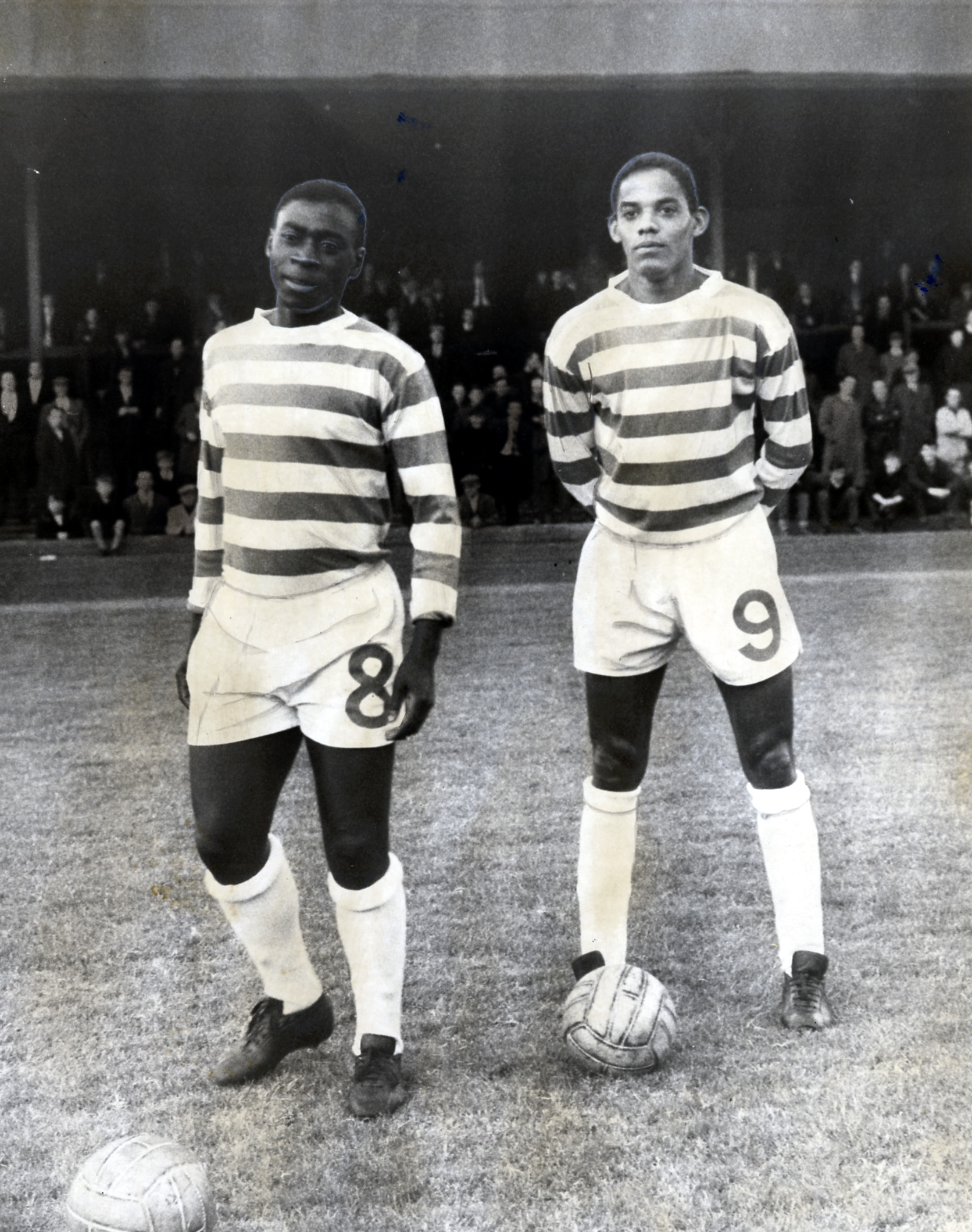
Inacio, di Sousa and Chico Filho were the first black players to represent any Scottish teams since Celtic’s Gil Heron in 1951, and were the first Brazilian players in Scottish football.
If they had succeeded to become first team players history could have been very different as Celtic fans take pride in that the Lisbon Lions were all homebred, but if all else remained the same, and one of the Brazilian had been a ‘Lisbon Lion’ then the support would have still taken much pride in a slightly different way.
5) 1967-78: Paul Wilson

His time at Celtic is a major point in the evolution of non-white players at Celtic, and helped pave the way for others much later. Disgustingly, opposition fans used to call him ‘Sabbu‘, a derogatory name against Black people which is best left for discussion elsewhere on a more appropriate website.
He was a homegrown success, playing for Celtic during the unforgiving insensitive 1970s era and was given the full support of the club management and support in the face of the relentless abuse from the opposition terraces. Society and football had to change, but at Celtic it was the case that people were accepted regardless of their background. Incredibly he was the only non-white player to have played for Scotland in the entirety of the twentieth century.
 6) 1988: Mark Walters of Rangers
6) 1988: Mark Walters of Rangers
There is no denying that at Celtic it has not all been plain sailing. Mark Walters of Rangers when he signed for their club was sadly & disgustingly harassed with racist abuse at his first match v Celtic, with a few sick minded people on the Celtic terraces throwing bananas towards him and one or two even in monkey suits. They were a minority and not reflective of the Celtic support in general but their behaviour was still unacceptable, and counter to the Celtic ethos. We cannot accept any abuse against any minorities.
The forefathers of the club were discriminated and oppressed, and Celtic was at inception set up to help the downtrodden in the Catholic communities in Scotland, an ethic at the club that expanded beyond the Irish-descent communities.
Racism and discrimination against any group of people (regardless of where they are from or what is their skin colour or creed) is NOT the Celtic Way or acceptable. Mark Walters gave a good report of Glasgow & Celtic to Paul Elliot, which paved his way to come to the club, so much respect to him for that.
7) 1989-91: Paul Elliott
The arrival of Paul Elliott, and the cult following he created at Celtic, helped to progress opinions and it was needed to help tackle any lingering racism amongst the most difficult stubborn minority.
Maybe if the celebrated Paul McGrath (a highly regarded black Irish international & Man Utd player) had come to Celtic earlier then it would have helped begin the process sooner than it did. Rangers player Mark Walters gave a good report of both Glasgow & Celtic to Paul Elliot, which paved his way to come to the club, so much respect to him for that.
The response from the overwhelming majority of the support was positive, and unlike at most other clubs across the UK, there was swift action to tackle the racism issue (both by the club and the support in general), which showed a positive progressive attitude and was a success. It should not mask what had occurred on occasions in the past but at least there was honesty & action. The Celtic support is a cross-section of society, so sadly there have been a minority who have harboured bigoted views, but the Celtic support do not tolerate it, and any bigoted supporters are unwelcome and should be moved on.
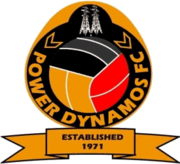 8) Jimmy Bone & Power Dynamos FC (of Zambia)
8) Jimmy Bone & Power Dynamos FC (of Zambia)
On a sidenote, ex-Celt Jimmy Bone has a great claim to fame. Probably his greatest achievement was in Zambia with Power Dynamos FC, managing the side to become the first team from southern Africa to win the [African] Cup Winners Cup, the first continental cup won by a southern African side. A wonderful achievement, and a great connection for Celtic with Africa and the development & growth of football. He had a strange recollection of the success:
Interviewer: “Bone masterminded victory in the African Cup Winners’ Cup – is there anything from that experience that might prove useful in the match?”
Jimmy Bone: “What, like black magic, you mean? There was a lot of it. Animals sacrificed and secret potions sprinkled in your socks for good luck, but if you found chicken-**** in your goalmouth that was bad luck. Before the final I told my players: ‘Dinnae bother about any of that. Today you’re Scottish.’ I was the only white guy in the stadium, but I made them sing Flower of Scotland with me. It did the trick.”
9) 1999-2000: John Barnes – First Black Manager of a premier club in Scotland

That was a major landmark. He may have not have gone on to be a success as a manager but that was due to his own inability.
Regardless, he was supported heavily by the Celtic board & support till it all dramatically unravelled. In any moments of clarity, he will have to clearly admit that Celtic were fully supportive, but sadly he has been publicly very vocal in his arrogance & delusions about his own record at Celtic & elsewhere.
Notably, in July 1999, Celtic defeated Newcastle 2-0 in a friendly, which possibly was the first time that two opposing managers of clubs in the UK (in the top tiers) were black. Albeit this was a friendly, but still a notable landmark.
10) 1997-2004: Henrik Larsson – Celtic’s Legendary player

He is of mixed race, and was taken to the hearts of all the Celtic support, and even after leaving the club he openly states his love for the club & supporters at every opportunity.
It was a measure of the Willie Maley quote of the acceptance and love for Henrik Larsson.
 11) 2018: Three Scorers: Celtic 3-1 Hearts, Jan 2018
11) 2018: Three Scorers: Celtic 3-1 Hearts, Jan 2018
In January 2018, Celtic defeated Hearts 3-1 in another match that pushed Celtic to the domestic treble. The three scorers were Edouard, Dembele and Ntcham. All three were of African descent (albeit now playing for European national sides), and of differing religious faiths, and no one batted an eyelid at Celtic.
The three were highly regarded, and were key players in the first team. In some ways this moment sealed the transition over the past few generations for non-white players. Coincidental that it was against Hearts as the first non-white player ever in a Celtic match was John Walker of Hearts (1898).
12) Bobo Balde at the African Cup of Nations (2003)
 Some players really fall in love with both Celtic & the support, and one cult favourite is Bobo Balde who even when out the side still enjoyed watching the first team play, even sitting amongst the support at an away match when still a player!
Some players really fall in love with both Celtic & the support, and one cult favourite is Bobo Balde who even when out the side still enjoyed watching the first team play, even sitting amongst the support at an away match when still a player!
As a measure of his love for the support, when at the 2003 African Cup of Nations (AfCoN), mindful of the fact that many African fans wore mainly locally-made replica shirts in honour of their favourite stars, decided to give his compatriots a treat.
“I brought about 100 tops from the club for some people here, because they support me and they support Celtic – and I wanted to thank them for that. it would be good to have lots of Celtic fans here in Guinea, and all over Africa too.”
The pictures of the Guinea fans at the games wearing Celtic tops en masse were incredible & truly humbling.
13) 2010s – Celtic youth players
 One of the next stages would be for a player from the growing population of black people of African descent in Scotland to make the step up.
One of the next stages would be for a player from the growing population of black people of African descent in Scotland to make the step up.
Scottish-Somalian Islam Feruz would have been the first player but he bunked off to Chelsea prematurely before even his first competitive match for Celtic, and his career soon floundered.
The first to play in a competitive match was the young Karamoko Dembele, but sadly he moved on prematurely mainly due to the lack of first team opportunities expected with the highly competitive squad under Ange Postecoglu.
14) The Future?
The future has already come. The first Celtic side was all Catholic and of Scottish & Irish descent, and it is highly celebrated that the Lisbon Lions 1967 European Cup winning side was all from the West of Scotland (a mixture of Catholics & Protestants).
Those solely homegrown days are likely all gone. All future sides will be cosmopolitan in their construction, and will encompass various people of differing nationalities, birthplaces, racial colours (mixed or not) and religions, and it will be as much to celebrate as that of the teams of our forefathers.
The rise of the African descent players and their successful integration into our club is another matter to be proud of. Only time will now tell how football will further evolve, but it will hopefully continue to be in a positive direction whatever happens.

Links
- Notable Matches:
Articles
When Celtic and Dunfermline were in thrall to the boys from Brazil
In this feature from the new edition of Nutmeg, Daniel Gray tells the story of a forgotten 1960s exotic invasion
By Daniel Gray
Sunday, 6th September 2020, 7:30 am
Updated
Sunday, 6th September 2020, 8:52 am
Ayrton Inacio and Marco di Sousa ahead of their Celtic bows in 1965.
https://www.scotsman.com/sport/football/celtic/when-celtic-and-dunfermline-were-thrall-boys-brazil-2962765
Jimmy Johnstone was not accustomed to them looking elsewhere. If the football pitch was a room, then he was that magnetic soul on whom all eyes fix upon entry. Now, thousands of Parkhead mortals stared beyond Jinky and inwards to a new twinkling presence. It was a minor deed of betrayal, like the actions of those wretches who glance over a person’s shoulder during conversation.
Johnstone needed their doe-eyed gazes and their boisterous plaudits. He needed tidings to reach Jock Stein, not long Celtic manager, that his was a talent worthy of First XI permanence. The winger had thus far etched many a poem in the saggy turf – enough melodious couplets to make green Glasgow purr, just not enough to escape the second team for good. Summer of 1965 folded into autumn and the name Jimmy Johnstone rested in pencil on that purgatorial middle teamsheet between firsts and reserves. The second last thing he needed was a dashing Brazilian team-mate vying for attention. The last thing he needed was two.
Celtic: Get the latest team news, match previews and reports
There were at least 11,000 spectators in the ground that day, September 4th, neglecting Johnstone during a tie between Celtic’s reserves and Motherwell’s. Most had come to see Ayrton Inacio and Marco di Sousa. Hope bloomed that the pair would be Pelé and Garrincha in Hoops, samba lads with a taste for square sausage. Perhaps it was time for Brazil to repay her footballing debt to Scotland; at last the fruits of the Charles Miller and Thomas Donohoe exchange. Both men were inside forwards. Inacio wore the number eight upon his shorts, di Sousa nine.
“He’s bulky”, wrote the Daily Record’s Hugh Taylor of the former, “…with the hip wiggle of a Carmen Miranda and one of the most spectacular shots to horrify Scottish goalkeepers in a long time.”
In the 18th minute, Inacio bowled into a Motherwell defender, purloined the ball from him and hammered it into the net. Seven minutes later, di Sousa nudged him through. Though wide of the goal, Inacio thwacked in a shot that swerved its way home as if cartwheeling along a rainbow. Hundreds of children ran over the cinder, on to the pitch and mobbed tomorrow’s heroes. It was, continued Taylor in the Record, “a Brazilian bombshell” and a “football fiesta”.
At the interval, Jinky stirred. In the second half, he scored a wondrous goal of his own. On came the children again. This time they huddled the wee man. Samba had not yet replaced the Gay Gordons.
A salesman with exotic stock
During the summer of 1965, Jose Ramos arrived in Glasgow with merchandise to flog. His stock was exotic: Brazilian footballers, available on trial for the price of an air fare and, that catch-all and elastic out-going, associated costs. The Portuguese advertised his wares indiscriminately and with the gusto of a door-to-door salesman on a first shift. Scottish clubs of all sizes were contacted and offered meetings among the heavy curtains and busy carpets of the Royal Stuart Hotel on Clyde Street. The interest of many officials was piqued by what must have seemed an impossibly tropical offering in the monochrome world of domestic football.
In the third week of July that year, Dunfermline manager Willie Cunningham – successor to Jock Stein at East End Park – met with Ramos. The Pars were floating high and happy, in the previous season finishing only a point behind champions Kilmarnock and as beaten Scottish Cup finalists. Managers have long sought personnel that will gild their squads, tipping them over the creative edge and into greatness; players that make “the difference”. Cunningham must have looked into Ramos’ eyes and seen trophies instead of pupils, just as a cartoon felon perceives dollar signs in those of someone he is about to exploit. On July 26th, his board authorised the flying over of two Brazilians: Alexandre Gabrielle, aged 20, and Joaquim “Chico” Filho, aged 25. Both, claimed Ramos, had starred for Juventus di Sao Paulo.
Ramos was smashing his sales targets. In early August, St Mirren received another two of his Brazilians, Fernando Azevedo and Roberto Faria. Faria faded quickly from view – perhaps the bright lights of Paisley distracted and beguiled him – while Azevedo was hailed in the local press as a “Top Brazilian”. Cue fever among Buddies, cue old men whistling The Girl from Ipanema on County Square and down by the Abbey. On the first Saturday in August, St Mirren played Northampton Town in a Charity Cup match at Love Street.
With international clearance stuck in the post somewhere between the Amazon and the Clyde, Azevedo was restricted to a half-time unveiling. His silky keepy-ups had supporters cooing in anticipation.
St Mirren, incidentally, lost two-nil and their young star, Archie Gemmill, broke an ankle.
A day later, Sunday August 8th, Gabrielle touched down in Scotland, with Filho following the next Wednesday. Both were due to meet Pars board members in the Royal Stuart Hotel. With clearance from the Brazilian FA still to arrive, and perhaps secreted in the same envelope as Azevedo’s, the Fifers called off the meeting and refused to reimburse Gabrielle and Filho’s air fares. On August 20th, Celtic welcomed four Brazilians of their own: Inacio and di Sousa, plus Fernando Consul and Jorge Farah. In unison they marched across the gravel outside Parkhead resembling a jazz quartet arriving at a Midwest roadside venue. Farah wore a suit jacket over a white polo-neck t-shirt and carried an Alitalia crew bag, di Sousa sported a suave corduroy blazer and waistcoat, Consul a beige jacket and tie and Inacio a casual sweater ideal for a Glasgow summer. He would soon upgrade to the kind of bulky knitwear that mid-century mothers insisted upon their sons wearing, the work of an insistent landlady in club digs, perhaps.
Come late August over in Fife, with paperwork cleared and passes stamped, Gabrielle and “Chico” Filho began to acclimatise. “I kind of looked after Chico,” recalls inside forward Bert Paton now. “I took him home for decent meals and things. He was a better player than the big lad [Gabrielle], who was a bit of a poser. The food was very strange to them. They were interested in finding different food to ours and not interested in our fish suppers. Even in those days they were worried about diet.”
Jock Stein couldn’t be swayed
A week on from Inacio and di Sousa’s exhibition against Motherwell Reserves, the fixture card offered a derby at Love Street – St Mirren versus Morton, that cantankerous old joust played first when Gladstone was prime minister. Whether schooled in the intricacies of Renfrewshire rivalry or not, Fernando Azevedo found himself in the home side’s starting line-up.
Were this tale one of romance rather than an intriguing curio, the first Brazilian to contest a league match in Scotland would defy baying voices from the tumbledown terraces to dance between the raindrops and score a hat-trick. Instead, Morton won 1-0 and Azevedo played only a solitary further game for St Mirren, against the boilermakers of Babcock and Wilcox in the Renfrewshire Cup. Some history sings and some ends in a whimper.
That same afternoon, Inacio and di Sousa once more wore the Hoops, this time in a reserve fixture at Clydebank’s Kilbowie Park. Jimmy Johnstone pulled the strings in a 7-1 victory, though Inacio again netted twice and this time di Sousa joined him on the scoresheet. It could never be enough to sway Jock Stein, though. Celtic’s tarot card showed not exotic incomers, but a flame-haired bantam genius from Viewpark. They released all four of the jazz quartet soon after the Clydebank game. Inacio tried his luck at Cliftonhill and scored a goal on his only league appearance for Albion Rovers. Two years on, in the 1967/68 season, he returned to Scotland once more, turning out twice for Clydebank. Of the other three Ramos commodities traded to Celtic, we know little. In Fife, Gabrielle failed to turn heads and was released on September 13th.
“I think he was just brought along to carry Chico’s case,” says Paton, below. Chico remained ready to dazzle, and was named as Dunfermline’s number 9 the following Saturday in a forward line incorporating a combative type from Govan, Alex Ferguson. Scottish league football’s second Brazilian would travel to Cappielow to face Morton, who by now must have been wondering where their own standard issue South American had got to. Chico neither scored nor impressed in a one-all draw by the Firth of Clyde.
Farewell to Fife
A second outing would not materialise and, by October, he had left Fife and bequeathed a souvenir to Paton: “When they eventually left, Chico said to me ‘I want to give you these boots.’ These boots, they were like slippers, such soft leather, and in those days they were nothing like our boots, which were more solid, stronger built. I was running about, showing off these new boots and all the other young lads were jealous. But with them being so soft, they ruined my two big toe nails. They got bruised to bits because they had no protection from players standing on your feet like our own boots had, no toe-caps. So they didn’t last very long. I swear my toes have never been right since.”
Paton was clearly unperturbed by the underwhelming dalliances of those Brazilians at East End Park. It was he, when manager of Dunfermline three decades later, that would sign two of their fellow countrymen. Following Sérgio Gomes’ 1995 spell at Dundee United, the Pars’ Sérgio Duarte and then Edinho became the fourth and fifth Brazilians to play league football in Scotland. “My wife reckons Duarte was the worst signing I ever made. That’s what she always says,” adds Paton now. “I knew he could take a free-kick, but that was about his limit.”
In a whirlwind spell between the autumn of 1997 and the late winter of 1998, Duarte played in a midfield beaten 7-0 by Rangers, man-to-man marked Henrik Larsson, bought a house in Rosyth and missed the team bus home following a Coca-Cola Cup semi-final defeat to Celtic. “Sergio has gone back to Brazil with his family,” said Paton upon his exit in March, “and he went pretty quickly as well. I don’t think he liked the weather in Scotland very much. And who can blame him?”
“I prefer the ball at my feet to play it on the ground, but that was not going to happen,” Duarte told the Edinburgh Evening News. Edinho, a friend of Duarte’s, joined on loan from Bradford City in November 1998, scored one goal in nine games and then returned to Valley Parade.
Ours, though, is a sixties yarn and not a nineties one. After Chico left Fife and Inacio departed Glasgow, Jose Ramos seemed to disappear, as a travelling salesman is prone to.
Whispers and tittle-tattle percolated. In football club board rooms, curses hung in the air alongside the usual maelstrom of Brut aftershave and cigar smoke. The word “perfidious” grew tired with overuse. A contemporary journalist conversed with a man named Peter Pullen, Brazil’s spokesman in Europe, who had not heard of Ramos nor his players, and commented “I don’t think that they are first-class.” Their credentials as significant figures in the history of football are more weighty: not only were they the first Brazilians to play in Scotland, but Inacio, di Sousa and Chico Filho were the first black players to represent Scottish teams since Celtic’s Gil Heron in 1951.
Whoever Ramos was and whatever his intentions, for a short while his players scattered Copacabana sand grains on Dalgety Bay and pulled the Maracanã towards Paisley. Fleeting as it was, lightning had struck and turned an old greying sport luminous.
• This feature appears in Issue 17 of Nutmeg, out this week and available via subscription at www.nutmegmagazine.co.uk
